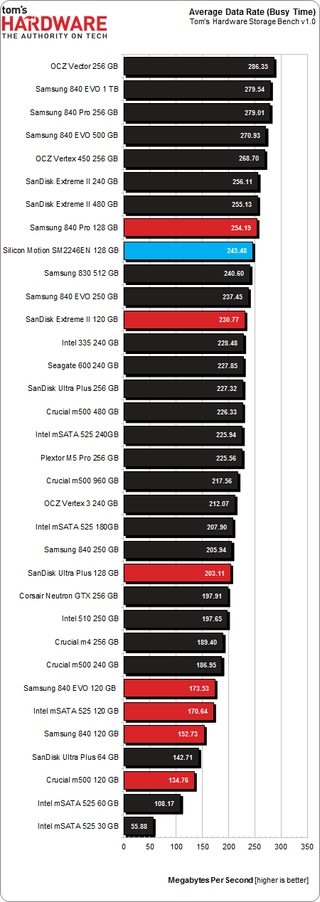Hands-On With Silicon Motion's New SSD Controller
Silicon Motion already makes flash storage controllers in all shapes and sizes. Now, with a new SATA 6Gb/s processor ready for action, the Taiwanese firm is hoping to make a dent in the market share currently enjoyed by SandForce and Marvell.
Results: Tom's Hardware Storage Bench v1.0
Storage Bench v1.0 (Background Info)
Our Storage Bench incorporates all of the I/O from a trace recorded over two weeks. The process of replaying this sequence to capture performance gives us a bunch of numbers that aren't really intuitive at first glance. Most idle time gets expunged, leaving only the time that each benchmarked drive was actually busy working on host commands. So, by taking the ratio of that busy time and the the amount of data exchanged during the trace, we arrive at an average data rate (in MB/s) metric we can use to compare drives.
It's not quite a perfect system. The original trace captures the TRIM command in transit, but since the trace is played on a drive without a file system, TRIM wouldn't work even if it were sent during the trace replay (which, sadly, it isn't). Still, trace testing is a great way to capture periods of actual storage activity, a great companion to synthetic testing like Iometer.
Incompressible Data and Storage Bench v1.0
Also worth noting is the fact that our trace testing pushes incompressible data through the system's buffers to the drive getting benchmarked. So, when the trace replay plays back write activity, it's writing largely incompressible data. If we run our storage bench on a SandForce-based SSD, we can monitor the SMART attributes for a bit more insight.
| Mushkin Chronos Deluxe 120 GBSMART Attributes | RAW Value Increase |
|---|---|
| #242 Host Reads (in GB) | 84 GB |
| #241 Host Writes (in GB) | 142 GB |
| #233 Compressed NAND Writes (in GB) | 149 GB |
Host reads are greatly outstripped by host writes to be sure. That's all baked into the trace. But with SandForce's inline deduplication/compression, you'd expect that the amount of information written to flash would be less than the host writes (unless the data is mostly incompressible, of course). For every 1 GB the host asked to be written, Mushkin's drive is forced to write 1.05 GB.
If our trace replay was just writing easy-to-compress zeros out of the buffer, we'd see writes to NAND as a fraction of host writes. This puts the tested drives on a more equal footing, regardless of the controller's ability to compress data on the fly.
Stay On the Cutting Edge: Get the Tom's Hardware Newsletter
Join the experts who read Tom's Hardware for the inside track on enthusiast PC tech news — and have for over 25 years. We'll send breaking news and in-depth reviews of CPUs, GPUs, AI, maker hardware and more straight to your inbox.
Average Data Rate
The Storage Bench trace generates more than 140 GB worth of writes during testing. Obviously, this tends to penalize drives smaller than 180 GB and reward those with more than 256 GB of capacity.

There isn't much to say about Silicon Motion's SM2246EN reference platform, other than that it falls just shy of the 840 Pro 128 GB and a few notches above the 120 GB Extreme II. Contributing factors include some really excellent read and write latency results gleaned from the trace, and we'll go into more depth on them here in a moment.
Other 128 GB-class SSDs are highlighted in red, with the Silicon Motion platform in blue.
Busy time accumulates when the SSD performs a task initiated by the host. So, when the operating system asks a drive to read or write, measured busy time increases. Take the total elapsed time and the amount of data read/written by the trace, and you get busy time in a far easy to understand MB/s figure. Unfortunately, busy time and the MB/s number generated with it aren't as adept at measuring higher queue depth performance.
Current page: Results: Tom's Hardware Storage Bench v1.0
Prev Page Results: Random 4 KB Performance Next Page Results: Tom's Hardware Storage Bench v1.0, Continued-
rolli59 Performance looks good, the question is with a new player on the market if it will affect market price to the benefit of users that have SSD boot/program drives up to 256GB.Reply -
4745454b While performance wasn't the best, it was more then acceptable. And then the power numbers looked great. Overall it's a great start. I'm interested in long term results as some controllers have had bugs in the past that have done bad things to people's data.Reply
And yes, great to see someone else enter in. While more players means you'll need to look harder at what SSD you are buying, at least we'll have the options. Which is always good, even if the options aren't as good as what you were hoping for. -
shin0bi272 Not that this isnt kinda cool but Taiwan is now part of China so its proper to call it China.Reply -
UmeNNis Reply11339051 said:Not that this isnt kinda cool but Taiwan is now part of China so its proper to call it China.
Ummm..... how exactly is "Taiwan now part of China"...?:sarcastic: -
mayankleoboy1 During the benchmarks, did you ensure that the Samsung EVO is not throttling due to high temps ?Reply
Maybe add a max temperature graph as well. -
e-z e Given time to mature this could be a real contender. Would love to see a follow-up once it hits the market.Reply -
zads Reply
If only this were the case, my job would be so much easier.11337088 said:Meanwhile, SandForce is the opposite. It'll sell you a turnkey solution, but you don't really get many knobs or dials in terms of customization.
Most Popular



